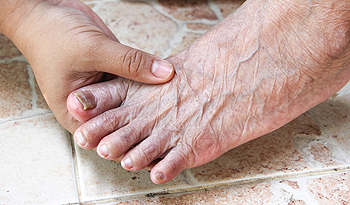
Sesamoiditis is a painful condition that affects the tendons around two small bones in the foot. These specialized bones, known as sesamoids, are unique in that they connect to muscles via tendons rather than to other bones. Typically, tendons become inflamed often due to overuse or repeated trauma, causing inflammation. This causes pain beneath the ball of the foot that gradually intensifies and may cause swelling or bruising. Certain activities, like running, basketball, or ballet, which impose considerable pressure on the ball of the foot, heighten the risk of developing sesamoiditis. Diagnosis involves a thorough physical examination to assess tenderness and limitations in mobility. A podiatrist will order imaging studies, such as X-rays, MRI scans, or ultrasounds to confirm the diagnosis and evaluate the extent of the condition. Treatment primarily focuses on lifestyle modifications, including modifying activity and changes in footwear. Pain management strategies such as custom orthotics and certain medications may also be prescribed. In severe cases where conservative measures fail, surgery may be necessary. If you are experiencing symptoms of sesamoiditis, it is suggested that you schedule an appointment with a podiatrist.
Sesamoiditis is an unpleasant foot condition characterized by pain in the balls of the feet. If you think you’re struggling with sesamoiditis, contact Dr. Anna Petrov of Family Foot & Ankle Care. Our doctor will treat your condition thoroughly and effectively.
Sesamoiditis
Sesamoiditis is a condition of the foot that affects the ball of the foot. It is more common in younger people than it is in older people. It can also occur with people who have begun a new exercise program, since their bodies are adjusting to the new physical regimen. Pain may also be caused by the inflammation of tendons surrounding the bones. It is important to seek treatment in its early stages because if you ignore the pain, this condition can lead to more serious problems such as severe irritation and bone fractures.
Causes of Sesamoiditis
- Sudden increase in activity
- Increase in physically strenuous movement without a proper warm up or build up
- Foot structure: those who have smaller, bonier feet or those with a high arch may be more susceptible
Treatment for sesamoiditis is non-invasive and simple. Doctors may recommend a strict rest period where the patient forgoes most physical activity. This will help give the patient time to heal their feet through limited activity. For serious cases, it is best to speak with your doctor to determine a treatment option that will help your specific needs.
If you have any questions please feel free to contact one of our offices located in Wheeling and Chicago, IL . We offer the newest diagnostic and treatment technologies for all your foot and ankle needs.

A broken foot often results from a sudden or traumatic injury and requires early recognition for appropriate treatment. While symptoms may overlap with less severe injuries like sprains, specific signs of a broken foot indicate a more serious issue needing immediate medical attention. Sensations of bones out of place or grinding within the foot may signal a break, warranting minimal movement to prevent further damage. Swelling, often accompanied by extreme pain, is common with a broken foot, persisting longer and more pronounced than a sprain. Bruising near the fracture site, spreading over time, indicates a broken foot, and requires evaluation from a podiatrist if persistent or worsening. Difficulty bearing weight on the foot, in addition to restricted movement and intense pain, suggests a broken bone. Immediate medical attention aids in accurate diagnosis and treatment planning. Seeking prompt evaluation from a podiatrist is imperative, and X-rays are essential for confirmation. Treatment typically involves immobilization with a splint or cast to support proper healing. If you suspect a broken bone in your foot, it is suggested that you make an emergency appointment with a podiatrist for an exam and diagnosis.
A broken foot requires immediate medical attention and treatment. If you need your feet checked, contact Dr. Anna Petrov from Family Foot & Ankle Care. Our doctor can provide the care you need to keep you pain-free and on your feet.
Broken Foot Causes, Symptoms, and Treatment
A broken foot is caused by one of the bones in the foot typically breaking when bended, crushed, or stretched beyond its natural capabilities. Usually the location of the fracture indicates how the break occurred, whether it was through an object, fall, or any other type of injury.
Common Symptoms of Broken Feet:
- Bruising
- Pain
- Redness
- Swelling
- Blue in color
- Numbness
- Cold
- Misshapen
- Cuts
- Deformities
Those that suspect they have a broken foot shoot seek urgent medical attention where a medical professional could diagnose the severity.
Treatment for broken bones varies depending on the cause, severity and location. Some will require the use of splints, casts or crutches while others could even involve surgery to repair the broken bones. Personal care includes the use of ice and keeping the foot stabilized and elevated.
If you have any questions please feel free to contact one of our offices located in Wheeling and Chicago, IL . We offer the newest diagnostic and treatment technologies for all your foot and ankle needs.

Foot pain among older adults is a common issue, often caused by wearing improper footwear and physical changes in the feet as a result of aging. Wearing ill-fitting shoes, such as those that are too small, narrow, or high-heeled, can lead to discomfort and an increased risk of falls. Over time, the natural cushioning under the heel and ball of the foot decreases and arches become flatter, all of which can contribute to foot pain. Furthermore, as the joints in the feet stiffen and skin becomes drier, vulnerability to foot infections increases. Many underlying health conditions, including diabetes, arthritis, neuropathy, poor circulation, and obesity can add to foot problems in older adults. A podiatrist can help to determine the cause or causes of foot pain in seniors, and is followed by a suggested program of treatment. Options may include wearing proper footwear, prescribing foot exercises, and creating custom orthotic devices to reduce the foot pain. If you are experiencing foot problems associated with aging, it is suggested that you schedule an appointment with a podiatrist.
Proper foot care is something many older adults forget to consider. If you have any concerns about your feet and ankles, contact Dr. Anna Petrov from Family Foot & Ankle Care. Our doctor can provide the care you need to keep you pain-free and on your feet.
The Elderly and Their Feet
As we age we start to notice many changes in our body, but the elder population may not notice them right away. Medical conditions may prevent the elderly to take notice of their foot health right away. Poor vision is a lead contributor to not taking action for the elderly.
Common Conditions
- Neuropathy – can reduce feeling in the feet and can hide many life-threatening medical conditions.
- Reduced flexibility – prevents the ability of proper toenail trimming, and foot cleaning. If left untreated, it may lead to further medical issues.
- Foot sores – amongst the older population can be serious before they are discovered. Some of the problematic conditions they may face are:
- Gouging toenails affecting nearby toe
- Shoes that don’t fit properly
- Pressure sores
- Loss of circulation in legs & feet
- Edema & swelling of feet and ankles
Susceptible Infections
Diabetes and poor circulation can cause general loss of sensitivity over the years, turning a simple cut into a serious issue.
If you have any questions please feel free to contact one of our offices located in Wheeling and Chicago, IL . We offer the newest diagnostic and treatment technologies for all your foot and ankle needs.







